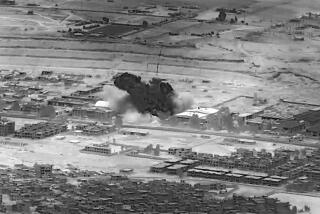U.S. Afghan raid takes some sniping at home
WASHINGTON — Three weeks after it took place, the only ground attack known to have been mounted by U.S. forces in Afghanistan is coming under criticism from some former special forces officers and military experts.
Some of the critics contend that the Oct. 19 raid, which struck an airfield and a residence of the Taliban’s leader in southern Afghanistan, misused stealthy special operations troops by deploying them as part of a noisy assault that also included a sizable force of U.S Army Rangers.
Others charge that U.S. commanders shouldn’t have risked the troops in an effort that -- with news leaks the night it happened and film footage afterward -- was primarily a show for the world news media. But other experts and special forces veterans contend that although the mission captured neither Taliban leaders nor key documents, it was well executed -- and that the more important question is why there apparently have not been more like it.
Pentagon officials continue to strongly defend the operation.
Although they acknowledged earlier this week that 31 troops suffered injuries in the attack -- significantly more than initially reported -- they say the injuries were all minor and not a result of enemy resistance. Air Force Gen. Richard B. Myers, chairman of the Joint Chiefs of Staff, called the mission “flawless.”
Many details of the raid remain murky. Military officials have said that it involved more than 100 Army Rangers, who met what they have described as only light resistance.
Military experts at Jane’s Information Group, the British defense publishing concern, dispute that, based on conversations with U.S. military sources. Since shortly after the raid, they have been contending that the U.S. forces ran into substantial resistance as soon as they approached the residence of the Taliban leader, Mullah Muhammed Omar, in the southern city of Kandahar.
Jane’s expert criticizes use of elite troops
Charles Heyman, a retired British major who is editor of Jane’s World Armies, said the U.S. forces met fierce resistance that demonstrated that Taliban forces “have to be softened up a lot more before we go risking valuable people” in such raids.
He said he believes that the raid on Omar’s house was led by Delta Force, the top-secret counterterrorism unit whose existence is not even publicly acknowledged by the Defense Department.
In his view, the use of Delta Force for the mission was a mistake. He said these commandos are best suited to operating in small units to gather intelligence and then call in warplanes or other forces to destroy selected targets. “That’s what they really do best,” Heyman said.
Even so, Heyman said that in his view the mission was well executed and probably did gain valuable intelligence by allowing the U.S. forces to gauge the reactions of the Taliban forces to the incursion.
Retired Army Col. David Hunt, a special operations veteran, said he would like to see the U.S. forces take a more aggressive role on the ground in Afghanistan. Yet he said he was disappointed to see the troops’ lives risked “as a P.R. tool. ... From my background, it’s insulting that we’re using guys to make us feel better.”
Andy Messing, a 17-year special forces veteran, faulted the military leadership for apparently combining the Army Rangers, who are elite light infantry, and the Delta Force commandos, who are trained to take more initiative in carrying out their missions. The Rangers “are great guys, but they just think and operate too differently,” said Messing, who runs a conservative think tank called the National Defense Council Foundation.
Other experts and special forces veterans strongly disagreed.
Retired Army Maj. Gen. David L. Grange, a former Delta Force member, said that while he couldn’t comment directly on use of the force, it is routine for the military to use counterterrorist commandos to try to kill or capture the enemy in such raids.
“That’s doctrinally correct,” he said.
He said the raid was also worthwhile because it clearly made the Taliban nervous to see U.S. forces so close. In addition, it was a morale lifter for U.S. forces and also demonstrated that “we would put U.S. boots on the ground, no matter how fleeting it was.”
“This had an impact,” said Grange, who is executive vice president of the Robert R. McCormick Tribune Foundation, the charitable arm of Tribune Co., owner of the Los Angeles Times.
Mission compared to bombing of Tokyo
He also disputed assertions that there were a number of U.S. casualties in the raid, saying that military commanders couldn’t conceal serious injuries.
An Army special operations officer, who spoke on condition of anonymity, said he believes that neither of the targets of the raid had real military significance.
But he compared the purpose of the raid to the token bombing of Tokyo at the outset of World War II -- “just to show we can do it,” he said.
Before U.S. forces mount another sizable attack, he said, they will want to be sure they have the kind of intelligence that will make the risks worthwhile.
“We want to know we can hit a double into the gap before we swing,” he said.
More to Read
Sign up for Essential California
The most important California stories and recommendations in your inbox every morning.
You may occasionally receive promotional content from the Los Angeles Times.










